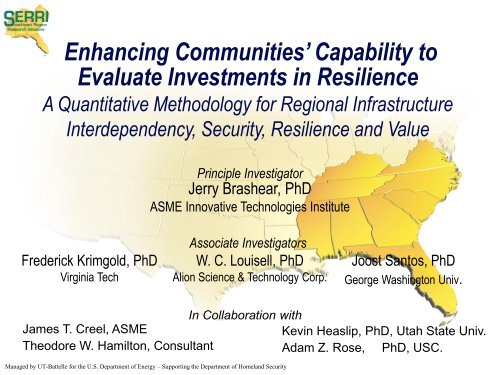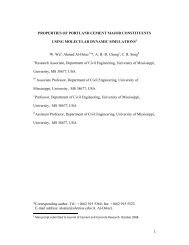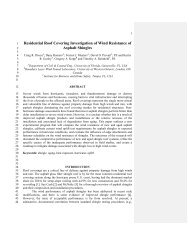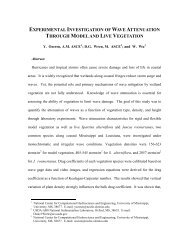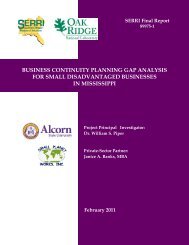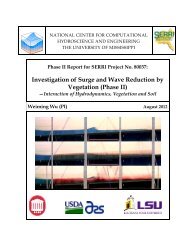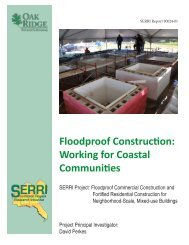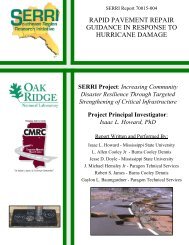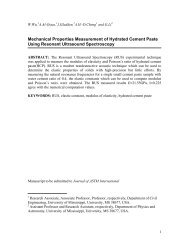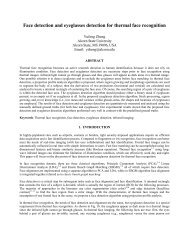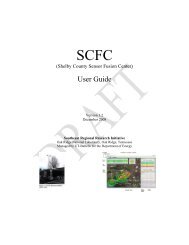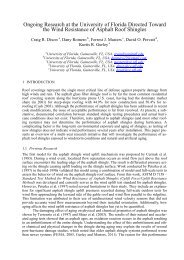October 2011 Review Meeting - Presentation Version (Brashear)
October 2011 Review Meeting - Presentation Version (Brashear)
October 2011 Review Meeting - Presentation Version (Brashear)
You also want an ePaper? Increase the reach of your titles
YUMPU automatically turns print PDFs into web optimized ePapers that Google loves.
Enhancing Communities’ Capability toEvaluate Investments in ResilienceA Quantitative Methodology for Regional InfrastructureInterdependency, Security, Resilience and ValuePrinciple InvestigatorJerry <strong>Brashear</strong>, PhDASME Innovative Technologies InstituteFrederick Krimgold, PhDVirginia TechAssociate InvestigatorsW. C. Louisell, PhDAlion Science & Technology Corp.Joost Santos, PhDGeorge Washington Univ.In Collaboration withJames T. Creel, ASMEKevin Heaslip, PhD, Utah State Univ.Theodore W. Hamilton, ConsultantAdam Z. Rose, PhD, USC.Managed by UT-Battelle for the U.S. Department of Energy – Supporting the Department of Homeland Security
ContactsJerry <strong>Brashear</strong> 301 704 8030 Jerry<strong>Brashear</strong>@gmail.comFred Krimgold 571 858 3307 Krimgold@VT.eduChuck Louisell 843 327 7807 WLouisell@alionscience.comJoost Santos 202 994 1249 Joost@GWU.eduJames Creel 202 785 7383 CreelJ@asme.orgKevin Heaslip 435 797 8289 Kevin.Heaslip@USU.eduManaged by UT-Battelle for the U.S. Department of Energy – Supporting the Department of Homeland Security
Regional Resilience Project• Objective: Design & test a general resilience/securitydecision support system that can be used for by virtually allmetropolitan areas, Nation-wide– Assess the level of resilience & security of a metro area‟s criticalinfrastructures, first responders, major economic drivers and theregion as a whole– Evaluate options for enhancing resilience & security where theyare unacceptable to Metro decision-makers – in a form directlyuseable in capital planning & budget-making• Status: Feasibility study design based on experience in 4regions– Originally to be a field-based, spiral development projectcovering three years– Funding limitations and inability of legal counsels to agree havecaused premature closureManaged by UT-Battelle for the U.S. Department of Energy – Supporting the Department of Homeland Security
Capability Gap:US Infrastructure at the Break Point• The foundations of Americanprosperity & competitiveness – itsinfrastructure – are crumbling• Age, neglect, over-use, wear andtear, structural failures, growth,natural hazards, even terrorismcause losses in lives andproductivity• America invests just 2.4% of GDP ininfrastructure, versus:– China: 9%– Europe: 5%• OECD: US ranks 15 th among developed countries, incl. India & China• World Economic Forum: US ranks 23 rd – after Spain, before Chile• Both aging and new infrastructures need investmentManaged by UT-Battelle for the U.S. Department of Energy – Supporting the Department of Homeland Security
Major Infrastructures Are Failing• Bridges: 27% "structurally deficient or functionally obsolete“; I-35W collapsekilled 13• Roads: cost US motorists 14,000 lives and $220 billion annually• Electricity: 2003 Northeast Blackout impacted 50 million people; blackoutlosses, near $0 in 1960, now run $100 billion/yearManaged by UT-Battelle for the U.S. Department of Energy – Supporting the Department of Homeland Security• Dams: 3500 “unsafe” and liable to fail,including 1800 endangering lives• Levees: Hurricane Katrina 1500 deaths;New Orleans may never recover fully• Water: 30% of pipes 40-80 yeas old; 10%more than 80; 10 billion gal. of raw sewagereleased annually• Overall: ASCE estimates that $2.2 trillion needed (vs. $1.6 trillion in 2005)
…But, Money Is Not the Only Requirement• The CSIS* Commission on Public Infrastructure concluded:• “We are both under-investing …and investing in the wrong projects…• “We lack the policy structures to make the correct choices andinvestments…”• The needed “project approval process would force all infrastructure modesto be evaluated using common methods and parameters”• The Challenge – an objective, analytic valuation process that yields directlycomparable estimates of value, costs, benefits, risks and resilience ofalternative investments• Essential for rational funding allocation toproduce maximum benefits• Needed urgently to support decisions thatwill determine value, security & resilience____________for the next 50+ years*Center for Strategic and International StudiesManaged by UT-Battelle for the U.S. Department of Energy – Supporting the Department of Homeland Security
ProbabilityRisk & Resilience Are Important, But Insufficient• Decision-makers seek to realize relatively higher outcomes• How can we expect decision-makers to focus on only atiny segment of the distribution of all possible outcomes?• Valuation of security/resilience options must be treated asstandard parts of the budget and compete with all othersGoal:0OutcomesManaged by UT-Battelle for the U.S. Department of Energy – Supporting the Department of Homeland Security
Requirements: Enable Capital Decisions*1. Be able to make direct comparisons2. Cover multiple objectives✔ 3. Handle upside (value, meeting future requirements) anddownside futures (risk & resilience)4. Include technological innovations5. Handle uncertainties✔ 6. Treat dependencies and interdependencies7. Be comprehensive in coverage of options✔ 8. “Optimize” portfolios of investments in budget context9. Be defensible and credible✔ 10. Estimate both public and private benefits & costs✔ 11. Be “simple” and efficient to use by municipal & utility staffs* By corporate CEOs, mayors, governors, the President, publicprivatepartnerships & their respective capital budget staffsManaged by UT-Battelle for the U.S. Department of Energy – Supporting the Department of Homeland Security
To repeat…K.I.S.S.** Keep Infrastructure Security SimpleManaged by UT-Battelle for the U.S. Department of Energy – Supporting the Department of Homeland Security
Financial vs. Infrastructure PortfoliosFinancial Assets Infrastructure Assets Analytic ToolsManaged by UT-Battelle for the U.S. Department of Energy – Supporting the Department of Homeland Security
Financial vs. Infrastructure PortfoliosFinancial Assets Infrastructure Assets Analytic Tools1. Develop goals, objectives,constraints, metrics: privateManaged by UT-Battelle for the U.S. Department of Energy – Supporting the Department of Homeland Security
Financial vs. Infrastructure PortfoliosFinancial Assets Infrastructure Assets Analytic Tools1. Develop goals, objectives,constraints, metrics: private2. Value existing portfolio – valuerisk; private perspective – gapanalysisManaged by UT-Battelle for the U.S. Department of Energy – Supporting the Department of Homeland Security
Financial vs. Infrastructure PortfoliosFinancial Assets Infrastructure Assets Analytic Tools1. Develop goals, objectives,constraints, metrics: private2. Value existing portfolio – valuerisk; private perspective – gapanalysis3. Assess new investmentopportunities individually4. Estimate correlations amongexisting & new assets ormarket (covariance/beta)Managed by UT-Battelle for the U.S. Department of Energy – Supporting the Department of Homeland Security
Financial vs. Infrastructure PortfoliosFinancial Assets Infrastructure Assets Analytic Tools1. Develop goals, objectives,constraints, metrics: private2. Value existing portfolio – valuerisk; private perspective – gapanalysis3. Assess new investmentopportunities individually4. Estimate correlations amongexisting & new assets ormarket (covariance/beta)5. Optimize investment portfolio –maximize value at accept-ablerisk level, within constraintsManaged by UT-Battelle for the U.S. Department of Energy – Supporting the Department of Homeland Security
Financial vs. Infrastructure PortfoliosFinancial Assets Infrastructure Assets Analytic Tools1. Develop goals, objectives,constraints, metrics: private2. Value existing portfolio – valuerisk; private perspective – gapanalysis3. Assess new investmentopportunities individually4. Estimate correlations amongexisting & new assets ormarket (covariance/beta)5. Optimize investment portfolio –maximize value at accept-ablerisk level, within constraints6. Select portfolio – privateperspectiveManaged by UT-Battelle for the U.S. Department of Energy – Supporting the Department of Homeland Security
Owner’s PerspectiveEconomic/Financial Consequence Analysis: TwoPerspectives NeededThe Public’s PerspectiveEvaluationfrom theInfrastructureOWNER’sPerspectiveNegativeIndifferentPositiveEvaluation from PUBLIC’s PerspectiveNegative Indifferent PositiveNo investment?Gov‟t pays orrequires owner toshare costOwner invests;gov‟t providesinducementOwner invests voluntarily –The business case is madeManaged by UT-Battelle for the U.S. Department of Energy – Supporting the Department of Homeland Security
Financial vs. Infrastructure PortfoliosFinancial Assets Infrastructure Assets Analytic Tools1. Develop goals, objectives,constraints, metrics: private2. Value existing portfolio – valuerisk; private perspective – gapanalysis3. Assess new investmentopportunities individually4. Estimate correlations amongexisting & new assets ormarket (covariance/beta)5. Optimize investment portfolio –maximize value at accept-ablerisk level, within constraints6. Select portfolio – privateperspectiveManaged by UT-Battelle for the U.S. Department of Energy – Supporting the Department of Homeland Security
Financial vs. Infrastructure PortfoliosFinancial Assets Infrastructure Assets Analytic Tools1. Develop goals, objectives,constraints, metrics: private1. Same, but both public &private goals, etc.2. Value existing portfolio – valuerisk; private perspective – gapanalysis2. Same, except from bothowner‟s and public‟sperspectives3. Assess new investmentopportunities individually3. Same, for new & renewalinvestment projects4. Estimate correlations amongexisting & new assets ormarket (covariance/beta)5. Optimize investment portfolio –maximize value at accept-ablerisk level, within constraints6. Select portfolio – privateperspective4. Same, except estimatephysical interdependenciesamong existing &new assets5. Same, but assure privateinvestments; thenmaximize value withinpublic constraints6. Same, but from public’sperspective onlyManaged by UT-Battelle for the U.S. Department of Energy – Supporting the Department of Homeland Security
Financial vs. Infrastructure PortfoliosFinancial Assets Infrastructure Assets Analytic Tools1. Develop goals, objectives,constraints, metrics: private1. Same, but both public &private goals, etc.Analytic HierarchyProcess (AHP)2. Value existing portfolio – value 2. Same, except from both Regional Input-Outputrisk; private perspective – gapanalysisowner‟s and public‟sperspectives3. Assess new investmentopportunities individually3. Same, for new & renewalinvestment projectsEngineering-Econ.Risk/Resilience Model4. Estimate correlations amongexisting & new assets ormarket (covariance/beta)5. Optimize investment portfolio –maximize value at accept-ablerisk level, within constraints6. Select portfolio – privateperspective4. Same, except estimatephysical interdependenciesamong existing &new assets5. Same, but assure privateinvestments; thenmaximize value withinpublic constraints6. Same, but from public’sperspective onlyRegional Systems &Systems-of-SystemsModelPortfolio OptimizerSensitivity analysisusing above toolsManaged by UT-Battelle for the U.S. Department of Energy – Supporting the Department of Homeland Security
Key DefinitionsRisk = Threat likelihood x Vulnerability x ConsequencesR = RiskC = Consequences to owner AND region caused by a threat eventV = Vulnerability, or the likelihood that a predefined attack or natural hazard will result inthe estimated consequences, given that the event occursT = Threat frequency, or likelihood, that the threat event will occur over a defined timeResilience is the ability to withstand an adverse event and/or recover to target levels ofservice delivery and quality within target amounts of timeResilience Indictor = (Duration x Severity of Service Denial) x V x TValue = Normalized Score on Priority-Weighted Multi-Attribute ObjectiveBenefits = Avoided Losses or Outages x (T x V)… and Value AddedKey Metrics• Fatalities & serious injuries• Financial and economic losses• Outage severity & duration• Value relative to multi-attribute objectives•Qualitative, e.g., military readiness, confidein governmentManaged by UT-Battelle for the U.S. Department of Energy – Supporting the Department of Homeland Security
Level of ServiceSeverityResilience & Security Add Value by ReducingService Outages & Losses, RespectivelyDisruption“New Normal”?AcceptableLevelService Outage withResilience Options??Service Outage withoutResilience OptionsPre-DisruptionDurationResponse Recovery RestorationTimeSlide 21Managed by UT-Battelle for the U.S. Department of Energy – Supporting the Department of Homeland Security
Approach: Assessment & Evaluation for EachSystem, Aggregated for the Regiona. Risk/ResilienceAssessment CycleImplementation& Management5. Decision-Makers‟Choices & Plans4. RegionalEconomic Impacts1. Decision-Makers‟Goals, Criteria& PrioritiesRegional ResilienceAssessment/EvaluationCycleb. Mitigation OptionEvaluation Cycle3. Systems &Interdependencies*Options Design/Description2. Facility Risk/Resilience/Value Analysis*(RAMCAP)Managed by UT-Battelle for the U.S. Department of Energy – Supporting the Department of Homeland Security
Approach: Assessment & Evaluation for EachSystem, Aggregated for the Regiona. Risk/ResilienceAssessment CycleImplementation& Management5. Decision-Makers‟Choices & Plans4. RegionalEconomic Impacts1. Decision-Makers‟Goals, Criteria& PrioritiesRegional ResilienceAssessment/EvaluationCycleb. Mitigation OptionEvaluation Cycle3. Systems &Interdependencies*Options Design/Description2. Facility Risk/Resilience/Value Analysis*(RAMCAP)Managed by UT-Battelle for the U.S. Department of Energy – Supporting the Department of Homeland Security
1. Objectives: Analytical Hierarchy Process (AHP)• Developed in 1970s at Wharton• Group consensus• Multi-attribute objective-setting –mixes quantitative & qualitative• Consistent priorities (weights)• Widely used in selecting amongoptions, sometimes large numbers• As implemented by DecisionLens®, AHP is simple and direct,with useful supporting capabilitiesDefine goal and objectivesDefine metrics for each objectiveCompare objectives pairwiseCalculate weights<strong>Review</strong> weights & metrics; adjustRate/calculate all options on themetricsRank by value and value/$SelectoptionsManaged by UT-Battelle for the U.S. Department of Energy – Supporting the Department of Homeland Security
Goal and Objectives for Projects & Programs• Overall goal: Select projects and programs that contribute to a vibrant, resilientmetropolitan area, considering:• Equity – option contributes to political, racial and economic balance among geographicand political groupings – perception and fact of "fairness" and distributional justice• Economic growth – option provides jobs for citizens, enhances the tax base, andbrings new industry into the area• Safety: reduce risk / enhance security – option reduces fatalities, injuries,departmental/organizational loss ($), direct loss to public ($), indirect/regional loss ($)• Resilience: enhance continuity of service – option adds to ability to withstand anundesired incident or, if not possible, to return to meeting demand for services quickly• Effective and efficient government – option adds to effectiveness and efficiency of themetro region's governments, as reflected in the net benefits, benefit/cost ratios andimpact on the tax revenue• Infrastructure adequacy – option contributes to ability of the infrastructure to meetnear- and longer-term demand for infrastructure services under normal conditions• Environmental sustainability – option enhances or avoids degradation of the naturalenvironment, including conservation of natural resources, reduction of pollution, etc.Managed by UT-Battelle for the U.S. Department of Energy – Supporting the Department of Homeland Security
Pairwise Comparisons among ObjectivesManaged by UT-Battelle for the U.S. Department of Energy – Supporting the Department of Homeland Security
Pairwise Comparisons among ObjectivesManaged by UT-Battelle for the U.S. Department of Energy – Supporting the Department of Homeland Security
Overall Objectives and WeightsManaged by UT-Battelle for the U.S. Department of Energy – Supporting the Department of Homeland Security
Priority-Weighted Selection ObjectivesEconomic GrowthEconomic GrowthExpanded EmploymentExpanded Tax BaseAttractiveness to industryResilience: enhance continuityResilience: enhance continuity of serviceOverall Regional economic losses ($)Direct loss to the publicOutage EstimatesSafety: Safety: reduce reduce risk/enhanced securityFatalitiesInjuriesDepartment/organizational losses ($)Effective & efficient governmentEffective and efficient governmentEffectiveness: Net benefitsImpact on tax recieptsEfficiency: Benefit/cost ratioEquityEquityInfrastructure adequacyEnvironmental sustainabilityInfrastructure adequacyEnvironmental sustainibilityManaged by UT-Battelle for the U.S. Department of Energy – Supporting the Department of Homeland Security0 0.05 0.1 0.15 0.2
Approach: Assessment & Evaluation for EachSystem, Aggregated for the Regiona. Risk/ResilienceAssessment CycleImplementation& Management5. Decision-Makers‟Choices & Plans4. RegionalEconomic Impacts1. Decision-Makers‟Goals, Criteria& PrioritiesRegional ResilienceAssessment/EvaluationCycleb. Mitigation OptionEvaluation Cycle3. Systems &Interdependencies*Options Design/Description2. Facility Risk/Resilience/Value Analysis*(RAMCAP)Managed by UT-Battelle for the U.S. Department of Energy – Supporting the Department of Homeland Security
2. Facility/Asset Risk/Resilience(New RAMCAP)• Goal: Rational allocation of resources to enhance value, security &resilience of critical infrastructures• Provide Common– Terminology– Process– Metrics– Reference scenarios• Changing requirements• Man-made attacks• Natural & proximity hazards• Supply chain disruptionsfor COMPARING RISKS AND RESILIENCE WITHIN AND ACROSSSECTORS at facility, system, region, state & national levels – across time• Inform decision-makers about value, risks & resilience in the private ANDpublic sectors• Support decision-making to enhance value, security & resilienceManaged by UT-Battelle for the U.S. Department of Energy – Supporting the Department of Homeland SecurityTailored to the specific technologiesand cultures of the individual sectors,while maintaining comparabilityCan be executed well in relativelyquickly by on-site personnel, withoutexperts
2. The New RAMCAP ProcessWhat facilities & assets do I have that are critical to myoperations?1) Asset Characterization2) Threat Characterization3) Consequence Analysis4) Vulnerability Analysis5) Threat AssessmentWhat reasonable worst case threat, natural hazard & supplychain scenarios should I consider?What happens to my assets & operations if attacked byterrorists, natural hazards or supply chain disruption? Howmuch money lost, to me? fatalities? injuries? How mucheconomic loss to the regional community?What vulnerabilities would allow a terrorist, natural disaster orsupply chain problems to cause these consequences? Giventhe scenario, what is the likelihood it will result in theseconsequences?What is the likelihood that a terrorist natural disaster or supplychain disruption will strike my operations?6) Risk / Resilience Assessment7) Risk / Resilience ManagementHigh Net-Benefit OptionsManaged by UT-Battelle for the U.S. Department of Energy – Supporting the Department of Homeland SecurityRisk = Consequences x (Vulnerability x Threat Likelihood)Resilience = Service Outage x (Vulnerability x Threat Lik.)Value = Extent of satisfaction of diverse requirementsWhat options do I have to reduce risks, increase resilience andvalue? How much will each benefit my organization? Myregion? How much will it cost? What is benefit/cost ratio of myoptions? How can I manage the chosen options?32
SystemicRequirements2. RAMCAPReference EventsEvent TypeEvent DescriptionRegional Economy Declines Level Moderate growth Major growthPopulation Declines Level Moderate growth Major growthManaged by UT-Battelle for the U.S. Department of Energy – Supporting the Department of Homeland Security33
SystemicRisk Requirements2. RAMCAPReference EventsEvent TypeEvent DescriptionRegional Economy Declines Level Moderate growth Major growthPopulation Declines Level Moderate growth Major growthNatural Hazards Hurricanes Earthquakes Tornadoes FloodsDependency &ProximityWear & AgingLoss of utilitiesLoss of transportationLoss ofsuppliersLoss ofemployeesProximity to other targetsUnder DevelopmentLoss of customersManaged by UT-Battelle for the U.S. Department of Energy – Supporting the Department of Homeland Security34
SystemicRisk RequirementsCrime/Accident2. RAMCAPReference EventsEvent TypeEvent DescriptionRegional Economy Declines Level Moderate growth Major growthPopulation Declines Level Moderate growth Major growthNatural Hazards Hurricanes Earthquakes Tornadoes FloodsDependency &ProximityWear & AgingLoss of utilitiesLoss of transportationLoss ofsuppliersLoss ofemployeesProximity to other targetsUnder DevelopmentLoss of customersProductContaminationSabotageTheft or DiversionChemical Radionuclide Biotoxin PathogenPhysical-insiderPhysical-insiderWeaponization of waste disposal systemPhysicaloutsiderPhysicaloutsiderCyber-insiderCyber-insiderCyber- outsiderCyber- outsiderManaged by UT-Battelle for the U.S. Department of Energy – Supporting the Department of Homeland Security35
SystemicRisk RequirementsCrime/AccidentTerrorism2. RAMCAPReference EventsEvent TypeEvent DescriptionRegional Economy Declines Level Moderate growth Major growthPopulation Declines Level Moderate growth Major growthNatural Hazards Hurricanes Earthquakes Tornadoes FloodsDependency &ProximityWear & AgingLoss of utilitiesLoss of transportationLoss ofsuppliersLoss ofemployeesProximity to other targetsUnder DevelopmentLoss of customersProductContaminationSabotageTheft or DiversionChemical Radionuclide Biotoxin PathogenPhysical-insiderPhysical-insiderWeaponization of waste disposal systemPhysicaloutsiderPhysicaloutsiderCyber-insiderCyber-insiderCyber- outsiderCyber- outsiderAttack: Marine Small boat Fast boat Barge Ocean shipAttack: Aircraft Helicopter Small plane Regional jet Long-flight jetAttack: Automotive Car Van Mid-size truck 18 - wheelerAttack: Assault Team 1 assailant 2-4 assailants 5-8 assailants 9-16 assailantsManaged by UT-Battelle for the U.S. Department of Energy – Supporting the Department of Homeland Security36
1) Asset Characterization2) Threat Characterization3) Consequence Analysis4) Vulnerability Analysis2. RAMCAP Features5) Threat Likelihood Assessment6) Risk / Resilience Assessment7) Risk / Resilience ManagementHigh Net-Benefit OptionsThe New RAMCAP• Estimates resilience indicator• No more “bins” – all quantitative• More complete hazards – natural,man-made, accidents, aging,dependencies, proximity• Event-tree vulnerability analysis• Terrorism likelihood proxy• Risk/resilience estimated forowner AND regional economy• Models distributed service deliverysystems, e.g., water, fire & police• Connects w/ „‟systems-of-system”model for interdependencies• Complete benefit/cost analysis• Formatted for budget decisions* RAMCAP: Risk Analysis and Management for Critical Asset ProtectionManaged by UT-Battelle for the U.S. Department of Energy – Supporting the Department of Homeland Security
Approach: Assessment & Evaluation for EachSystem, Aggregated for the Regiona. Risk/ResilienceAssessment CycleImplementation& Management5. Decision-Makers‟Choices & Plans4. RegionalEconomic Impacts1. Decision-Makers‟Goals, Criteria& PrioritiesRegional ResilienceAssessment/EvaluationCycleb. Mitigation OptionEvaluation Cycle3. Systems &Interdependencies*Options Design/Description2. Facility Risk/Resilience/Value Analysis*(RAMCAP)Managed by UT-Battelle for the U.S. Department of Energy – Supporting the Department of Homeland Security
Loss ( % of total value)Conceptual Model of Fire ProgressionNote: different curves bybuilding type, use & ageHazard CaseFlashoverOptionCase AConsequence Benefitswith Option AConsequenceBenefitswith Opt. BConsequencesof HazardIgnitionOptionCase BBase CaseTime in minutesSlide 39Managed by UT-Battelle for the U.S. Department of Energy – Supporting the Department of Homeland Security
Concept for Fire SuppressionUtilitiesHQ & DistrictCommand911(911ResponseTime)PersonnelEquipment(non-rolling)FireStationAirMaintenanceRollingEquipment& PersonnelFuelBased on total time & station location, estimate:• Service Denial/Delay• Property Loss ($)• Fatalities & InjuriesManaged by UT-Battelle for the U.S. Department of Energy – Supporting the Department of Homeland SecurityWater(UnderPressure)Infrastructures involved:1.Private telecom2.Emergency Comm‟s3.Fire Department4.Water Department5.Public WorksIncident(ResolutionTime)MobileFuelMobileAir6. Electric utility7. EMS8. Hospitals9. Police10. Motor fuels
Infrastructures Deliver Via a System of Nodes andLinks• For each Effect of Interest, a Three-Step Process is used– Identify Critical Infrastructure Elements– Identify Infrastructure Dependencies– Identify Critical Cross-DependenciesSourceTreatmentPlantPumpsStorageTanksPoint ofServiceTransformerCircuitSubstationManaged by UT-Battelle for the U.S. Department of Energy – Supporting the Department of Homeland Security
A Baseline Infrastructure Dependency ModelManaged by UT-Battelle for the U.S. Department of Energy – Supporting the Department of Homeland Security
Distribution Defines Infrastructure Response to ScenariosControl CenterSub-Station 1Pump Station 2Sub-Station 3Control CenterF3 TornadoTower 3Pump Station 1Sub-Station 2Pump Station 3Tower 2Dispatch CenterTower 1Managed by UT-Battelle for the U.S. Department of Energy – Supporting the Department of Homeland Security
Operational Agility of each InfrastructureDefines Impacts on Service DeliveryManaged by UT-Battelle for the U.S. Department of Energy – Supporting the Department of Homeland Security
Infrastructures Affect Other Infrastructures andElectrical PowerServicesTransportationWaterFireSuppressionEmergency CommunicationsManaged by UT-Battelle for the U.S. Department of Energy – Supporting the Department of Homeland Security
Approach: Assessment & Evaluation for EachSystem, Aggregated for the Regiona. Risk/ResilienceAssessment CycleImplementation& Management5. Decision-Makers‟Choices & Plans4. RegionalEconomic Impacts1. Decision-Makers‟Goals, Criteria& PrioritiesRegional ResilienceAssessment/EvaluationCycleb. Mitigation OptionEvaluation Cycle3. Systems &Interdependencies*Options Design/Description2. Facility Risk/Resilience/Value Analysis*(RAMCAP)Managed by UT-Battelle for the U.S. Department of Energy – Supporting the Department of Homeland Security
Inoperability Input-Output Model• A regional system capable of assessing economic losses due todisasters• Based on input-output (I-O) analysis, and utilizes data from:– Bureau of Economic Analysis I-O data– Regional Input-Output Multiplier System (RIMS II)– Gross Domestic Product– Local Area Personal Income– IMPLAN data for higher-resolution sector analysis• Primary metrics– Economic loss per sector– Sector Inoperability, or percentage deviation from ideal productionoutput level– Resilience, a measure of recovery pace• Scenario Definition (user-provided)– Initial inoperability by sector– Time to recover by sectorManaged by UT-Battelle for the U.S. Department of Energy – Supporting the Department of Homeland Security
Sample Metro Results• Shown below are simulated results for a 10% productivity disruption toMetro‟s economic sectors– Total regional loss of $210 millionManaged by UT-Battelle for the U.S. Department of Energy – Supporting the Department of Homeland Security
Approach: Assessment & Evaluation for EachSystem, Aggregated for the Regiona. Risk/ResilienceAssessment CycleImplementation& Management5. Decision-Makers‟Choices & Plans4. RegionalEconomic Impacts1. Decision-Makers‟Goals, Criteria& PrioritiesRegional ResilienceAssessment/EvaluationCycleb. Mitigation OptionEvaluation Cycle3. Systems &Interdependencies*Options Design/Description2. Facility Risk/Resilience/Value Analysis*(RAMCAP)Managed by UT-Battelle for the U.S. Department of Energy – Supporting the Department of Homeland Security
5. Decision-Makers‟ Choices & Plans: AHPManaged by UT-Battelle for the U.S. Department of Energy – Supporting the Department of Homeland Security
Value1. Regional goals, Objectives &Constraints(2). Existing Portfolio(Baseline)Regional Resilience Portfolio SelectionGOALObj. 1 Obj. 2 Obj. 32. Facility Analysis1) Asset Characterization(2-4.) Assure PrivateSector InvestmentsProject Owner RegionRegionalEconomicModelImplement,Evaluate &ReiterateNewRenewNewRenewRenewNewPrioritizedProjectsSelected forFunding2) Threat Characterization3) Consequence Analysis4) Vulnerability Analysis5) Threat Assessment6) Risk Assessment7) Risk ManagementEngineering-Economics Model3.. DependencyAnalysisRegional DistributedSystems & Systems-of-Systems Models5.Decision-MakingCombination of Owners,Public Jurisdictions &Public / Private Partnerships4. RegionalEconomicAnalysisRegionalEconomicsModel2-4. RegionalBenefit/Cost andValue-RiskOptimizationProject Owner RegionRiskBenefit/Cost &“Portfolio” ModelsManaged by UT-Battelle for the U.S. Department of Energy – Supporting the Department of Homeland Security51
Benefits of Regional Resilience ApproachFor owners & operators (public & private):• Provides value, risk, resilience & benefit estimates• Permits comparisons across like and unlike assets in budget format• Enables understanding of hazards due to interdependencies• Assures service reliability & accountability – while measuring progress•Enhances value, security, & resilience of infrastructures & econ. DriversFor public sector decision-makers:•Provides directly comparable value, security- and resilience-enhancement baselineand benefit information – for the region as a whole- Incorporates distributed service & interdependencies explicitly for holistic solutions- Prioritizes investments in portfolio context – dependencies, objectives & constraints- Incentivizes private investment decision-making- Identifies potential market failures & externalities- Disciplines public funding- Supports service reliability & accountability – while measuring progress• Serves as basis for funding proposals – budget-oriented; grant competitionsContributes to more secure, resilient and valuable CRITICAL infrastructures,economic drivers, regions – and nation – for the 21 st centuryManaged by UT-Battelle for the U.S. Department of Energy – Supporting the Department of Homeland Security
Collaborative Opportunities• This project provides the only known quantitative, fully scalable,bottom-up approach to resilience and security on the critical scale ofmetropolitan regions• It complements the work by CARRI and others to developmetropolitan-scale organizational processes• Four metropolitan regions have contributed experience to the projectto date; others, especially robust public-private partnerships, will bewilling and ready if properly engaged• Commercial potential may bring major technology, consulting orbusiness process firms into the development process• As the process is proven, a major “bottom-up” national programcould be established to allow regions to design their own programsbased on a consistent, comparable, transparent process – benefitingboth regions and, in aggregate, the NationManaged by UT-Battelle for the U.S. Department of Energy – Supporting the Department of Homeland Security
Gantt Chart of Remaining WorkID123Task NameRegional Resilience InitiativeRegional Resilience InitiativeDetailed outline of of templateReport Summary on of budgeting processSeptember <strong>October</strong> November December9/4 9/11 9/18 9/25 10/2 10/9 10/16 10/23 10/30 11/6 11/13 11/20 11/27 12/44Report on multiple objectives, criteria, and & metrics5Report Summary of of facility/asset risk/resilience methodology6Report Summary on regional potential economic impacts impacts7Report Summary on on distributed interdependencies services & interdependencies8910Report Summary on on defining evaluating & evaluating infrastructure infrastructure options optionsDraft Template template integrating all all items the aboveORNL <strong>Review</strong> & by DHS ORNL <strong>Review</strong>11Final Final Template template with with plan plan on for further future developmentManaged by UT-Battelle for the U.S. Department of Energy – Supporting the Department of Homeland Security
Technology Readiness Level (TRL) Assessment• The project is an adaptation andintegration of several technologies,with some invention to close gaps• The present project will prove theconcept feasible and define the workremaining• Additional field-based developmentwill be needed to assure thefeasibility of the process• After that development, field testingin diverse regions will be necessaryto assure commercialityManaged by UT-Battelle for the U.S. Department of Energy – Supporting the Department of Homeland Security
Project Progress Summary0 10 20 30 40 50 60 70 80 90 100Budget Status: 55 % of budget expended; total outlay will be ~ 75%.Technical Status:Schedule Status:N/A: Technical objectives and Schedule re-definedSummary of Progress• The experience gained in 4 months of actual field work (plusexperience in 3 other regions) form the basis for theTemplate• The Template demonstrates the feasibility of the approachand the gaps that must be filled to complete it• The potential is great for the Template to serve many metroareas – or as the basis for a major Federal programManaged by UT-Battelle for the U.S. Department of Energy – Supporting the Department of Homeland Security
Summary & Conclusions• A decision-support system to allocate funds to options toenhance resilience, security & value on the metropolitanscale is desperately needed• Such a system has been fully specified and shown to befeasible – this project may well be unique in taking abottom-up, quantitative, scalable approach• The present project defines and delineates the elements ofthis system and specifies the work to bring it fully intocommerciality and application• Additional development and testing are needed to performthis work• When completed, the system could rationalize resourceallocation to maximize the value of American infrastructureManaged by UT-Battelle for the U.S. Department of Energy – Supporting the Department of Homeland Security
Thank YouJerry <strong>Brashear</strong>, PhDSenior FellowASME Innovative Technologies Institute, LLC301 704 8030Jerry<strong>Brashear</strong>@gmail.comManaged by UT-Battelle for the U.S. Department of Energy – Supporting the Department of Homeland Security
RAMCAP Background• 2002: White House meeting of senior executives – 1 st priority: method forcomparability in quantitative risk assessments – RAMCAP ®• 2/09: RAMCAP published as all-sector, all-hazard handbook (3.0 4.0)• 2005-09: Completed Sector-Specific Guidance documents for:1. Chemical manufacturing plants2. Petroleum refineries3. Liquefied natural gas terminals4. Nuclear power plants• 2005: ASME-ITI holds 1st National Conference on Regional Resilience• 2003-07: Team engaged in major regional resilience/dependency projects• 2009: Infrastructure Investment Portfolio Feasibility Study published• 2010: Water & Campus RAMCAPs now designated American NationalStandards; All-Sector Standard started• 2010: Online, 20-hour RAMCAP Plus training program launched• <strong>2011</strong>: RAMCAP-driven method for medical, academic & industrial nuclear• <strong>2011</strong>: Regional Resilience ProjectManaged by UT-Battelle for the U.S. Department of Energy – Supporting the Department of Homeland Security5. Nuclear spent fuel storage & transport6. Dams and locks7. Water and wastewater systems8. Campuses of higher education


